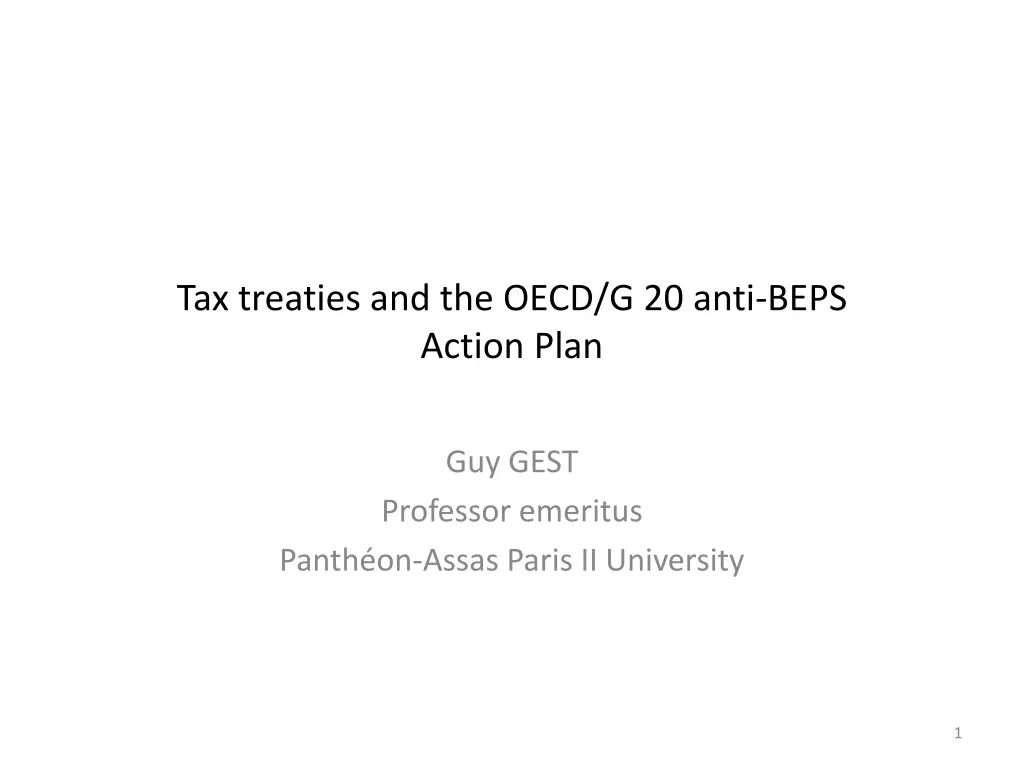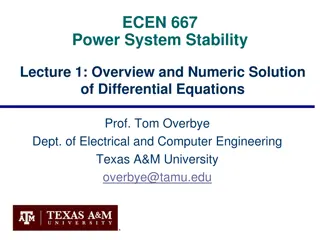
Tax Treaties and OECD/G-20 Anti-BEPS Action Plan Insights
Explore the significance of tax treaties in the OECD/G-20 anti-BEPS action plan, understanding the need for addressing treaty-related BEPS issues, and the proposed measures to combat such challenges effectively.
Download Presentation

Please find below an Image/Link to download the presentation.
The content on the website is provided AS IS for your information and personal use only. It may not be sold, licensed, or shared on other websites without obtaining consent from the author. If you encounter any issues during the download, it is possible that the publisher has removed the file from their server.
You are allowed to download the files provided on this website for personal or commercial use, subject to the condition that they are used lawfully. All files are the property of their respective owners.
The content on the website is provided AS IS for your information and personal use only. It may not be sold, licensed, or shared on other websites without obtaining consent from the author.
E N D
Presentation Transcript
Tax treaties and the OECD/G 20 anti-BEPS Action Plan Guy GEST Professor emeritus Panth on-Assas Paris II University 1
Tax treaties and the OECD/G 20 anti-BEPS Action Plan WHY ? Why tax treaty issues in the OECD/G 20 anti-BEPS Action Plan ? WHAT ? Which treaty measures against BEPS ? HOW ? Which is the most efficient way to implement those measures ? WHEN ? What time frame for such implementation ? WHO ? Which States will implement such measures ? 2
WHY ? Why tax treaties and BEPS ? The Cyclopean goal of the OECD/G 20 crusade against BEPS (recall) Tax treaties as a necessary part of that crusade The need for addressing the shortcomings of tax treaties that facilitate BEPS The flaws in a system designed in the 1920s Almost exclusively oriented against double taxation Exacerbated by globalization And going further, introducing in tax treaties provisions intended to counter BEPS 3
WHAT ? Which measures ? A limited ambition No (overtly) intended revisiting of the architecture of international taxation International standards for source-based versus residence-based taxation unchanged Though some de facto impact of the measures undertaken on the source-residence balance The approach The fight against treaty-related avoidance in order to protect countries corporate tax bases The two main actions dedicated to tax treaties Action 6 : Preventing tax treaty abuse Action 7 : Preventing the artificial avoidance of permanent establishment status A necessary supplement Action 14 : Making dispute resolution mechanisms more effective The insertion of the proposed measures in the OECD Model Tax Convention (MTC) and its Commentary 4
Treaty anti-abuse provisions Treaty anti-abuse provisions : the general approach The OECD new friendly piece of advice : think twice before entering a treaty with some countries Enshrining the anti-tax avoidance/evasion purpose in the treaty itself (title and preamble) A key factor in the interpretation of treaties but not always sufficient The need to supplement this with general and/or specific anti-abuse treaty rules A minimum standard to counter treaty abuse (at least treaty shopping) New targeted rules to address specific forms of treaty abuse other than treaty shopping A saving clause to counter the utilization of treaty provisions in order to neutralize domestic anti-abuse rules and judicial doctrines Great flexibility Proposals to be adapted to each country s specificities and the negotiation of treaties Choice of options ( within the minimum standard itself) 5
Treaty anti-abuse provisions A saving clause In order to counter the use of treaty benefits to circumvent domestic anti-abuse legislation or judicial doctrines in cross-border situations A US type clause confirming that the treaty does not restrict a Contracting State s right to tax its own residents Except for those specifically listed provisions 6
Treaty anti-abuse provisions The Minimum Standard Option A : a comprehensive LOB clause A US style anti-treaty shopping clause (limitation on benefits) Treaty protection only granted to those residents: being qualified persons, or benefitting from the derivation benefits clause , or satisfying the active business test , or benefitting from the discretionary relief clause . The pros and cons Legal certainty : a set of alternative and mostly objective mechanical tests Awesomely complex Unable to capture all forms of treaty shopping and other abuses Needs to be supplemented with a specific domestic or treaty-based anti-conduit rule or doctrine 7
Treaty anti-abuse provisions The Minimum Standard Option B : a Principal Purpose Test (PPT) rule Treaty benefit denied if obtaining it was one of the principal purposes of the arrangement or transaction Very comprehensive approach Beyond treaty shopping Very low anti-abuse threshold one of the principal purposes Unbalanced burden of proof High degree of legal uncertainty for bona fide commercial arrangements 8
Treaty anti-abuse provisions The Minimum Standard Option C : a combination of PPT rule and simplified LOB clause A simplified LOB clause to address the most obvious cases of treaty shopping Simplified, but still complex Other cases to be addressed under the PPT rule But both clauses operating independently from each other A combination of the most efficient / dangerous provisions 9
Treaty anti-abuse provisions A series of specificanti-abuse rules Most of them upgraded from the OECD MTC Commentary to the Model itself MAP as a new tie-breaker rule for dual resident entities Subjectivity and risk of double taxation Lowest wihholding tax treaty rate on dividends (qualified holdings) Subject to a minimum holding period (365 days) The situs State s right to tax capital gains (real estate entites) Extended to all interests (beyond shares) in real estate entities so qualified at any time during the 365 days preceding the alienation Hybrid entities Denying treaty benefits where neither State treats the income of a hybrid entity as the income of one of its residents (see BEPS Action 2) Permanent establishment triangular cases Counter the transfer of assets to a PE in a third State offering a preferential treatment 10
Widening the definition of permanent establishment Proposed Changes in Permanent Establishment (PE) definition An obviously needed reexamination Considering the changes in the way business is conducted worldwide A challengeable approach to such reexamination : treaty abuse Action 7 = Preventing the artificial avoidance of permanent establishment status A partial redundancy with Action 6 (treaty abuse in general) Some changes not merely countering tax avoidance through PE arrangements A risk of reaching a result unsatisfactory as regards an appropriate balance of taxing rights The necessary link between the PE definition and the attribution of profits to PE postponed to further work 11
Widening the definition of permanent establishment 1 - Lowering the Agency PE Threshold An extensive approach to the scope of an agent s actions on behalf of the foreign enterprise In addtion to agents concluding, but not signing contracts Agents concluding contracts without any active negotiation (standard contracts) Agents not concluding the contract but playing the principal role leading to the conclusion (without modification) by the enterprise An extensive approach to the type of contracts handled by an agent Beside the contracts in the name (disclosed or not) of the enterprise Contracts concluded by commissionnaires Legally binding on the agent Creating no rights/obligations between the enterprise ans its clients But to be performed by the enterprise Provided the agent/commissionnaire is not of an independent status 12
Widening the definition of permanent establishment 2 Restricting the scope of the Independent Agency exception The independent agent is one which : Conducts an autonomous business Bears the entrepreneurial risks Acts in the ordinary course of its business as an agent Provided it is not acting exclusively or almost exclusively on behalf of one or more enterprises to which it is connected A safe harbour : a buy-sell distributor is not a PE Even a low risk distributor Regardless of how long it holds title in the product sold Even when it is associated with the enterprise 13
Widening the definition of permanent establishment 3 - Tightening the specific activity exemptions from PE status Tightening preparatory or auxiliary activity exemptions All listed treaty exemptions must be Of a true preparatory or auxiliary nature In light of their role within the business considered as a whole An anti-fragmentation rule activities by an enterprise or a group of closely-related enterprises carried on at the same place or at different places complementary functions that are part of a cohesive business operation An aggregation rule to counter the splitting up of construction contracts In addition or in lieu of a general PPT provision For the application of the 12 month threshold 14
Strengthening dispute resolution mechanisms The need for robust / widely supported dispute resolution mechanisms (Action 14) - The well-known weaknesses of current mutual agreement procedures (MAP) and arbitration - A key aspect of the implementation of the BEPS recommendations For governments A level playing field For businesses Expanded government weaponry - more taxes levied - new reporting and compliance burdens more uncertainty - diverging interpretations - hence increase in cases of double taxation The risk of an exponential rise in the MAP caseload as a result of implementation of BEPS measures 15
Strengthening dispute resolution mechanisms How to achieve robust / widely supported dispute resolution mechanisms ? Objectives Ensuring full implementation of treaty obligations Improving administrative processes Ensuring businesses can access MAP Ensuring timely resolution of cases once they are in MAP Commitments and recommendations An agreed upon minimum standard (with a peer-based monitoring mechanism) A set of recommended best practices An optional commitment to mandatory MAP arbitration 16
Strengthening dispute resolution mechanisms A minimum standard for dispute resolution Main commitments Provide MAP access as to the application of a domestic or treaty (PPT) anti-abuse rule Seek to resolve cases within 24 months Publish clear rules and guidelines to access and use of the MAP Provide the staff in charge of MAP with competence, authority and independence Provide adequate human/financial resources Clarify the relationship between MAP and audit settlements Permit a request for MAP to be made to the Competent Authority of either State Identify the information/documentation to be submittted with a request for MAP Implement MAP agreements notwithstanding domestic law time limits A peer-based monitoring mechanism Conducted by the OECD Forum Tax Administration (FTA) MAP Forum 17
Strengthening dispute resolution mechanisms A set of recommended best practices Main recommendations Commit to eliminating double taxation resulting from primary transfer pricing adjustments (include paragraph 2 of Article 9 MTC in treaties) Publish mutual agreements likely to affect the interpretation or the application of treaties Implement bilateral APA (Advanced Pricing Agreement) programmes and provide guidance on APAs and multilateral MAPs Provide for a suspension of collection procedures pending the resolution of MAP cases Clarify the relationship between the MAP and domestic law administrative or judicial remedies Take into account bona fide taxpayer-initiated foreign adjustments Provide guidance on interest and penalties in the MAP 18
Strengthening dispute resolution mechanisms Mandatory Binding MAP Arbitration A solution favored by many businesses Commitment by 20 countries to provide such arbitration in their treaties In order to guarantee resolution of treaty-related disputes within a specified timeframe 20 countries involved in 90 % of outstanding MAP cases Japan, New Zealand, Australia, USA, UK, Germany, France Which arbitration approach ? No detail in the final Report Further work 19
HOW ? How to implement the treaty related measures ? The catch-all multilateral instrument (Action 15) A consensus-based approach A legal innovation The modification of the bilateral treaty network Simultaneous, speedy, efficient, consistent and coordinated Embracing all anti-BEPS tax treaty-related measures 20
HOW ? How to implement the treaty related measures ? The catch-all multilateral instrument A Utopia ? Technical and legal difficulties Drafting the multilateral instrument Inserting its provisions in existing/future bilateral treaties Conflicts of law (e.g. EU freedoms) Political difficulties In achieving a consensus : Which flexibility ? Opt-ins/outs or/and a minimum standard ? In obtaining domestic approval In avoiding future treaty override An ad-hoc Group to draw up the multilateral instrument Open to all interested States : 87 participating But no obligation to sign it when finalized A deadline : 31 December 2016 21
WHEN ? The implementation agenda for the BEPS Plan The October 2015 final reports Actions 6 (treaty abuse), 7 (PE), 14 (disputes), 15 (multilateral instrument) Further work New measures to be finalized in 2016, independently from the multilateral instrument Establishing the peer-based monitoring mechanism for the minimum standard on dispute resolution Monitoring process beginning in 2016 and first reports by the end of 2017 New measures to be finalized in 2016 and included in the multilateral instrument Review of the LOB rule in the light of its 2015 new US version (action 6) Treaty entitlement of non-CIV funds (action 7) Additional guidance on the issue of attribution of profits to PE (action 7) Drafting a mandatory binding MAP arbitration clause (action 14) Finalization of the multilateral instrument before 2017 (Action 15) 22
WHO ? Which States to implement the BEPS Plan ? The BEPS reports = morally binding instruments (P. Saint-Amans) Which implementation by the OECD/G 20 members ? Pre-multilateral instrument implementation e.g. the June 2015 France-Colombia tax treaty Implementation through the multilateral instrument The biggest challenge : keeping the consensus alive The risk of an aggravated chaos A peacemeal approach : BRICS ? A wait and see approach : the US not participating in the Ad-hoc Group Which implementation by the non-OECD/non-G 20 countries ? Developing countries and BEPS Their participation in and association to the BEPS Project A dialogue process (regional networks) The working out of toolkits to assist them implement BEPS action items (e.g. tax incentives) 23






















